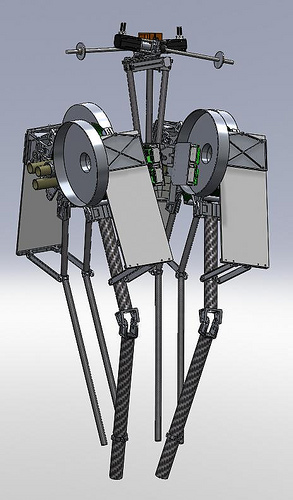You know what I am talking about. Yep, the blurb will read "taking on dangerous missions in the military" but we know it means whacking wholesome rebels in a galaxy far, far away.
Credit: Wikipedia, though how they get away without a lawsuit is beyond anyone's understanding.
Currently, robotics is nowhere near as interesting as Isaac Asimov led us to believe it would be by now. Robots are basically doing a job people hate and so would do poorly because they are mind-numbingly dull, like picked something off of an assembly line or welding the same thing 1,000 times a day.
The Holy Grail of robotics research is a world where robots can move like humans or animals - no easy thing outside science fiction. We can move easily over almost any terrain, using a balance of bone and tendon and meat, and even compensate for outside forces, like holding a cup of coffee level during a bumpy car ride - all without a lot of calories.
Turns out those two abilities are mutually exclusive, say the OSU researchers, and that becomes part of the energy problem for robots. Humans deal with problems by flexing opposing pairs of muscles to change the dynamic properties of our arms but for robots, the more it does of one, the less able it is to do of the other.
Robots look, well, robotic, when trying to walk. Good luck getting robots to walk like this:
Researchers can design robots that level out their gait to be stiff but functional yet the energy requirement is too much for practical applications, says Jonathan Hurst, an assistant professor of robotics and mechanical design at OSU.
"Researchers have been working toward robot locomotion for a long time based mostly on experience and intuition," said Hurst. "What we've done is taken a step back to analyze the fundamental dynamics of the mechanical system, what behavior is really possible for a given robotic system. A rock can't fly, no matter what software you write for it."
Here is what they have come up with so far.

Photo courtesy of Oregon State University
See??? What did I tell you? If that isn't an Imperial Walker AT-AT right out of "The Empire Strikes Back" I don't know what is. If you're old you may think it is something from "War of the Worlds" but you get my point.
This design is attempting to converge on the best of both worlds, says Hurst. "If robotic locomotion is ever to achieve some of what we want, it will have to use less energy. There are machines that can walk with no active controls at all, using barely any energy, but they fall if they run into the smallest bump. We need to use as much of that passive ability as possible and only use motors or active controls if it's really necessary, so we can save energy in the process."
They didn't get the concept from the second-best "Star Wars" movie but rather from ostriches. Ostriches have a great ability to respond to unexpected disturbances while running and can teach designers how to attain the needed robotic equivalent – combining spring-mass models with force control actuators.
It could also help them to win what's called the "W" Prize, a $200,000 award promised for the first robot that can move 10 kilometers within 10,000 seconds, through and over obstacles, using less energy than it would take a human to do the same task. And they got a $750,000 grant from the Human Frontiers Science Program, administered through the National Science Foundation to get it going.
"Long term, there's no reason we shouldn't be able to build robots or robotic devices with excellent locomotion ability," Hurst said. "Clearly this might be useful for some military or police applications in highly dangerous situations. But I could also see great improvements possible with prosthetic limbs that work much better than existing technology, or even the creation of exoskeletons that might allow someone with limited motor ability to walk effectively."
So if we don't get an Imperial Walker, we should at least get a Terminator.



Comments